What Is a Cap Crimping Machine?
In industrial packaging, securely sealing products is essential for quality and safety. A cap crimping machine (or cap crimper) is specialized equipment designed to apply a permanent, tamper-evident seal by crimping metal caps around the necks of bottles or vials. Cap crimpers mechanically deform an aluminum or metal ring-cap so that its edges fold under a circular flange at the top of the container. This action compresses any internal rubber stopper or liner, creating an airtight, leak-proof closure. The result is a hermetic seal that prevents leaks, contamination, and tampering.
Crimped closures are favored when non-removable, secure seals are needed. For example, packaging experts note that crimp capping is commonly used for products like perfumes, cosmetics, and injectable pharmaceuticals. In pharmaceutical labs, crimp caps on vials ensure sterility for sensitive tests; they are generally more reproducible and robust than screw caps. Overall, cap crimping machines improve product integrity and shelf life in sectors such as pharmaceuticals, chemicals, cosmetics, and beyond.
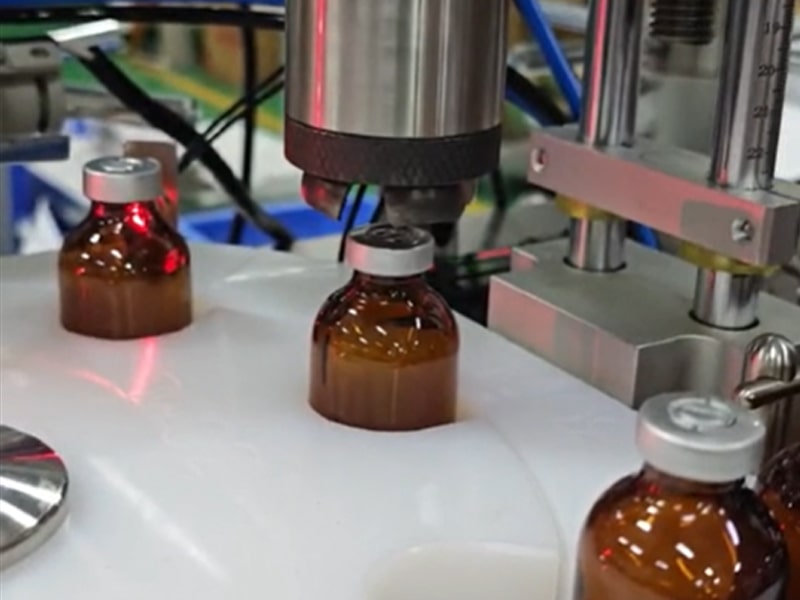
Types of Cap Crimpers
Cap crimping equipment comes in many forms, suited to different scales and containers. Below is a summary of key types:
| Type | Description | Typical Use / Throughput |
|---|---|---|
| Manual Cap Crimper | Handheld or small bench-top tool. The operator uses mechanical force or a simple lever to crimp each cap. Low throughput; useful for lab samples or very small batches. | Lab & R&D settings (e.g. sealing a few vials or bottles by hand). |
| Semi-Automatic | Tabletop or floor-standing machine with one or few crimp heads. Operator loads each container and initiates crimping (often via foot pedal). Moderate speed (tens of containers per minute). | Pilot lines, cosmetics, small pharma runs; moderate volumes (e.g. tens of vials/minute). |
| Automatic (Inline) | Fully automated system with conveyors or rotary turret. Multiple crimp heads (e.g. 4–24+) crimp continuously as containers flow through. High throughput (hundreds per minute) with PLC control and HMI. | High-speed packaging lines in pharma, beverage or chemical plants; up to 400+ containers/min. |
| Vial Crimping Machine | Specialized for small glass or plastic vials (typically 10–20 mm flip-off caps). Can be bench-top or inline. Uses folding jaws or blades to seal flip-off aluminum caps with rubber stoppers. | Injectable drug vials, lab sample vials in biotech/pharma; sterility-critical applications. |
| ROPP Capper | Roll-On Pilfer-Proof (ROPP) capping machine. Seals larger bottles with aluminum or metal screw caps by threading/forming under the bottle lip. Often rotary cappers for glass/plastic bottles. | Beverages (wine, spirits, juices), food jars (sauces), chemicals and oils – large-volume packaging. |
Additional variations include aerosol can crimpers (for internal valve sealing) and monoblock systems (which combine filling, stoppering, and crimping).
For example, manual crimpers or simple bench units allow operators to crimp a few vials by hand, which is sufficient for laboratory or small-scale uses. Semi-automatic machines improve consistency by automating the crimp action while still requiring manual loading – an operator places a vial under the crimp head and the machine then crimps it. In contrast, fully automatic crimpers integrate into conveyor lines with cap feeders and robotics. These machines (sometimes called automatic vial crimpers) can run at high speeds – one rotary crimper design for pharmaceuticals can run up to 400 bottles per minute and is controlled by an industrial PLC.
In summary, the choice depends on throughput and container type: small vial crimping machines are built for flip-top lab vials, while industrial cappers (like ROPP cappers) are geared toward large bottles. Tabletop semi-automatic models are common in cosmetic or R\&D lines, whereas pharmaceutical or beverage plants often use multi-head inline machines with quick-change tooling.
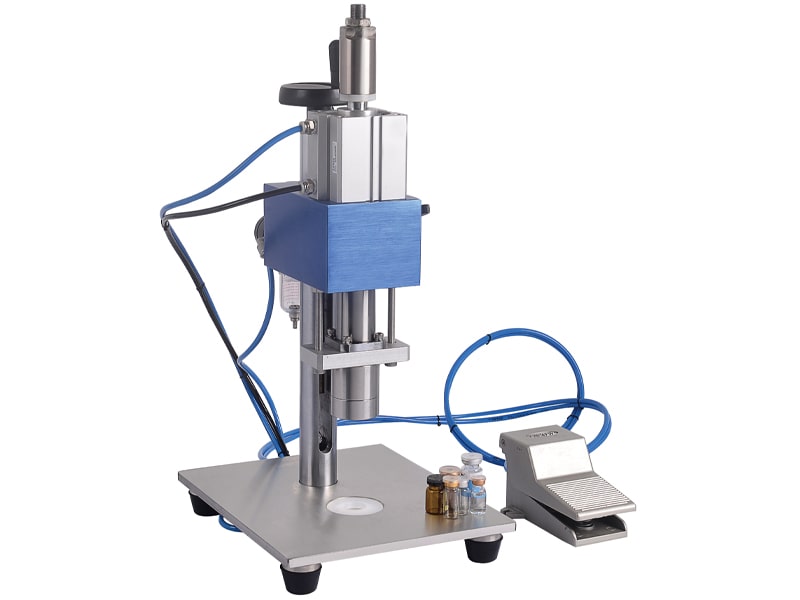 |
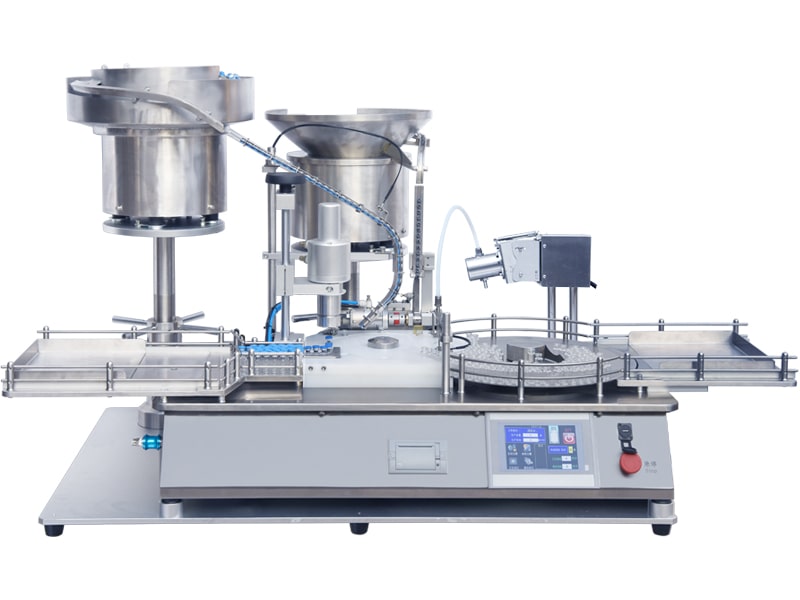 |
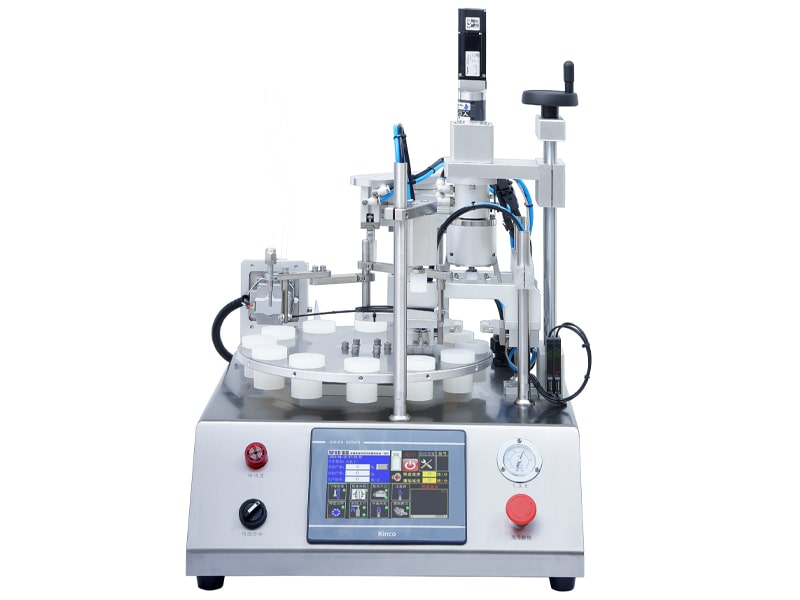 |
| XBZG-50 Semi-automatic Vial Capping Machine | Desktop vial filling production line | XBZP-25 series desktop ceramic pump filling and capping (capping) machine |
Working Principle of Cap Crimping
Crimping transforms a loose cap into a tight, permanent seal. In general, the container (bottle or vial) is presented under the crimping head, often held by a top hold-down or support, and then mechanical jaws or rollers deform the cap edge under the container’s neck ring. All cap crimping tools, from handheld to high-speed machines, work by forming the cap around the container lip. The exact mechanism varies, but the goal is the same: fold the cap’s rim down around the flange (or lip) on the container, compressing the seal (rubber or liner) inside.
The main mechanical methods are:
● Segmented Jaws (Multi-jaw Crimping): The crimping head has several jaws (typically three or four) that contract radially around the cap. The chuck is placed over the cap, and as it actuates, the jaws move inward, bending the cap’s lower rim upward under the neck ring. A central plunger or solid plug often holds the vial vertically from above during this action. As the jaws fold the cap inward, they simultaneously squeeze the rubber stopper or seal inside, ensuring a leakproof gasket. This simple method — even hand crimpers use multiple jaws — produces a uniform 360° crimp. (One example: in a 4-jaw crimper each jaw shapes one quarter of the cap edge.)
● Rotating Chuck with Cammed Rollers: In this approach, a rotating chuck descends onto the cap. A top hold-down or block presses the cap onto the container while cam-driven rollers around the chuck spin. As the chuck rotates, the wheels or rollers travel around the cap edge, progressively folding it under the container’s ring. In practice, when the crimping head (with rollers) comes down, the container is either stationary on a turret or moves up into it. This method is common in continuous-motion cappers. Single-head machines may use a single rotating chuck, while high-speed rotary machines use multiple rotating heads to achieve higher throughput.
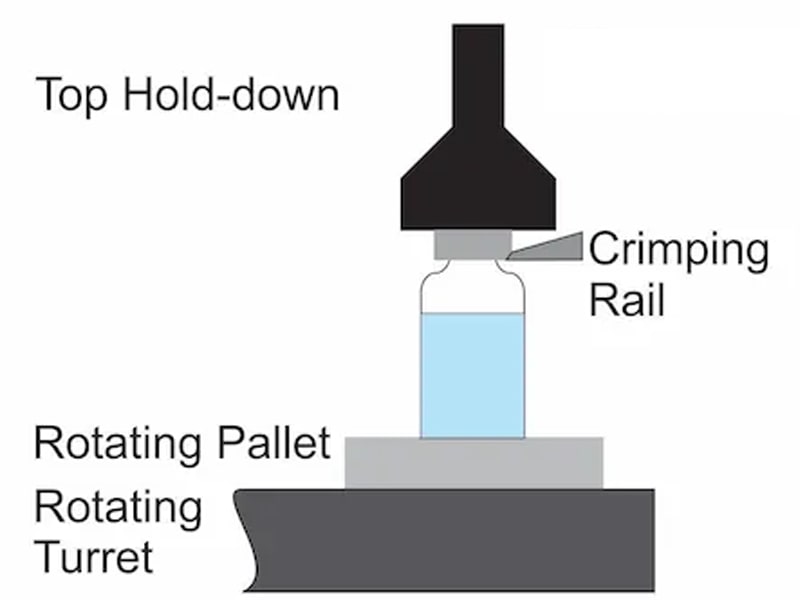
● Stationary Rail: In a rail-based crimper, the bottle is placed on a rotating indexer under a fixed curved rail. A top press holds the cap in place while the bottle rotates on its own axis. As each vial or bottle spins, its cap’s edge is pressed against the stationary rail, which folds the metal down and under the neck ring. This combination of rotation and a fixed rail achieves a tight, even crimp around the entire circumference. (The embedded diagram illustrates this method: the vial is on a rotating turret, the top hold-down clamps it, and the cap edge is progressively crimped by the fixed rail.)
● Internal Aerosol Crimping (Valve Sealing): Aerosol cans use a special internal crimp. After the can is filled and charged with propellant, the valve assembly (with gasket) is placed into the neck. The crimping jaws then expand inside the can’s mouth. The jaws press the valve cap downward, compressing the gasket, while a mandrel or piston forces the jaws outward to crimp the valve flange under the neck. This creates a permanent internal seal around the aerosol valve. (This method is used for spray cans and inhalers where the closure is on the can’s inside.)
Each of these methods ends with a uniformly deformed cap and a compressed seal beneath it. The final shape of the crimp is defined by the tooling (jaws or rollers) – there is no adjustment for “tightness” beyond tool design. Operators verify seal quality by appearance (smooth sides, slight seal indentation) or by mechanical testers. In all cases, the principle is the same: apply pressure and folding action around the cap so that it cannot be removed without destruction, locking the cap as a permanent closure on the container.

Applications and Benefits of Crimp Sealing
Cap crimping machines are widely used wherever a secure, tamper-evident seal is critical. Pharmaceuticals & Biotech: Many injectable drugs, vaccines, and lab reagents are packaged in glass vials with flip-off aluminum caps. Crimp sealing is the norm here, because it ensures sterility and consistent sealing pressure. Packaging experts note that crimp caps are often preferred over screw caps for analytical vials (e.g. headspace GC vials) due to their reproducibility and safety. In clinical and lab settings, sealed vials can withstand high pressures and temperatures without leaks, which is essential for processes like autoclaving or high-temperature analysis.
Cosmetics and Personal Care: Perfumes, lotions, and other cosmetics frequently use crimped closures. For example, metal caps on fragrance bottles are crimped onto the glass neck, providing an elegant, permanent seal that consumers cannot easily tamper with. The tight seal preserves product integrity (no evaporation or contamination) and gives a premium feel. Packaging Digest specifically lists perfumes and cosmetics as common crimped products. In addition, aerosol-based cosmetics (hairsprays, deodorants) rely on internal crimping of the valve to ensure the product does not leak or lose pressure.
Food, Beverage & Chemicals: Roll-on pilfer-proof capping (a form of crimping) is used in the food and beverage industry for items like wine, juices, sauces, and oils. For example, wine bottles often have an aluminum foil cap that is crimped over the cork and bottle lip to prevent leakage and tampering. Automated ROPP cap cappers apply multiple downward rolls to the cap to form the threads under the neck ring. In chemicals and agrochemicals (pesticides, cleaning agents, lubricants), crimped metal caps secure hazardous liquids. A directindustry report notes that specialized ROPP machines are used to seal glass bottles with metal caps in pharmaceuticals, food, distilleries, dairy, cosmetics, chemicals, beverages and more.
Other Applications: Besides these, crimping is used for laboratory autosampler vials (to seal samples for analytical instruments) and for certain electronics (e.g. battery terminals). Many aerosol cans (paint spray, cooking spray) use internal crimp seals as described above. In all these cases, the goal of crimp sealing is the same: create a permanent, leak-proof, and tamper-indicating closure. This enhances shelf life, maintains sterility (for drugs), prevents evaporation of volatile contents, and provides evidence if a container has been opened.
Integrating a Cap Crimper into an Automated Line
Cap crimping machines are often integrated into larger packaging lines for efficiency. In practice, a crimper can be a standalone station or part of a monoblock system. Inline Integration: Containers are fed into the crimper by conveyors or rotary tables. For example, vials may be delivered to the capping station via a stainless-steel belt or accumulating star wheel. Sensors (photoeyes) ensure each vial is present and correctly positioned before crimping. A top-held plunger or guider rails stabilize the vials while a cap is placed (often by a feeder or robotic arm). After crimping, vials exit onto the next conveyor (to labeling or inspection).
Modern crimpers feature programmable logic controllers (PLCs) and touch-screen HMIs for precise control. This allows easy changeover between different cap sizes or container formats. Vibratory cap feeders automatically orient and supply caps to the machine. Operators can adjust crimp depth or roller pressure via the PLC. Many machines include safety interlocks and in-line rejection for misaligned or missing caps. In a semi-automatic bench unit, the operator manually places each vial and the machine’s belt or chain then transports it under the crimping head. In high-speed models, the entire process is synchronized: a vibratory feeder drops a cap onto each vial, then the turret rotates the vial under the closing jaws, all coordinated by servo motors.
Monoblock Systems: For high-volume pharma or biotech, cap crimpers are often combined with filling and stoppering in a single rotary monoblock. In such machines, one turret handles successive steps: cleaning, filling liquid, inserting a rubber stopper, and finally crimping an aluminum cap. Automated Machine Technologies, for instance, offers monoblocks where a servo liquid filler, stopper, and crimper are integrated on one frame. This minimizes footprint and increases efficiency since vials travel on one platform. Quick-changeover tooling (swappable crimp heads and mandrels) lets the line switch formats in minutes.
Automation Features: Many cap crimpers can interface with plant control systems. For example, they may support OPC or Ethernet communication for data logging (counts, torque, alarms). PLC logic handles feedback from torque or seal sensors (if installed). Servo-driven crimpers allow programmable crimp force and position, improving consistency. Cameras or vision systems can inspect the crimp after sealing. In practice, a manufacturer would place the crimper after the stoppering machine on a conveyor, with sensors upstream/downstream. The crimper’s PLC would signal when to start each cycle, and a centralized SCADA system could monitor its status.
In summary, integrating a cap crimper involves linking it mechanically (conveyors, grippers) and electronically (PLC, HMI, sensors) with the rest of the line. By doing so, manufacturers achieve fully automated packaging – from filling to capping to labeling. The benefits are higher throughput, consistent seal quality, and reduced manual labor. For instance, an integrated system can run at hundreds of vials per minute with caps fed and crimped automatically. Proper integration and control are key to maximizing the crimper’s value in an efficient production workflow.
Frequently Asked Questions (FAQs)
1.What is a cap crimping machine and how does it differ from a cap crimper?
A cap crimping machine is the full automated or semi-automatic equipment that deforms metal caps around bottle or vial necks to create a permanent seal. A cap crimper often refers to handheld or bench-top versions used for manual or low-volume crimping. Both achieve the same hermetic seal, but the machine integrates into production lines for higher throughput.
2.What types of caps can a vial crimping machine handle?
A vial crimping machine is designed for small flip-off aluminum caps and rubber stoppers on glass or plastic lab vials (typically 10–20 mm). It can handle various stopper heights and cap diameters by quick-change jaws or mandrels, ensuring consistent crimping across vial sizes.
3.How does an automatic vial crimper improve production efficiency?
An automatic vial crimper integrates with conveyors, cap feeders, and PLC controls to crimp at speeds from 50 to over 400 vials per minute. It minimizes manual handling, reduces downtime for changeovers, and provides precise, reproducible seals—boosting throughput and lowering labor costs.
4.Can a cap crimping machine be integrated with existing filling and labeling lines?
Yes. Most cap crimping machines support conveyor or rotary turret interfaces, PLC and HMI communication (Ethernet/IP, OPC), and in-line sensors. This allows seamless integration after a filler or stopper, and upstream/downstream data exchange with labeling, inspection, and packaging systems.
5.What is the typical maintenance schedule for a semi-automatic cap crimper?
Routine maintenance for a semi-automatic cap crimper includes daily cleaning of jaws and mandrels, weekly lubrication of moving parts, and monthly inspection of jaw alignment and sensor operation. Annual preventive checks by certified technicians ensure long-term reliability.
6.How do I select the right cap crimping machine for my product line?
Consider your container type (vial vs. bottle), cap material and diameter, required throughput (manual, semi-auto, or automatic), integration needs (monoblock vs. standalone), and regulatory standards (e.g., GMP, FDA). A packaging specialist can perform a line audit to recommend the optimal model.
7.What are the key quality checks after crimping?
Standard checks include visual inspection of uniform crimp height and profile, torque testing to measure seal tightness, and leak tests (vacuum or pressure decay). For pharmaceuticals, sterility and seal integrity tests (dye ingress, microbial challenge) are also performed.
8.Are cap crimping machines suitable for corrosive or hazardous chemicals?
Yes. Many machines use stainless steel (304 or 316L), FDA-grade seals, and explosion-proof electrical components. Some models offer inert gas purging and sealed enclosures to protect both the product and equipment from corrosive or volatile substances.
9.What is the difference between ROPP cappers and standard cap crimping machines?
ROPP (Roll-On Pilfer-Proof) cappers form pilfer-evident screw threads on bottles by rolling the cap material around the neck ring. Standard cap crimpers fold the cap’s rim under the flange for a non-reversible seal. ROPP is common in wine, spirits, and food jars, while crimping is favored for vials, aerosols, and pharmaceuticals.
10.How can I validate that my automatic vial crimper meets regulatory requirements?
Validation involves Installation Qualification (IQ), Operational Qualification (OQ), and Performance Qualification (PQ) protocols. Documented testing of torque, seal integrity, and repeatability under worst-case conditions is required. Many equipment suppliers provide validation protocols and support to help meet FDA, EU GMP, and other regional standards.
| References: | |
| 1. | VIAL STOPPER COMPATIBILITY: CRITERIA AND TESTING METHODS FOR PHARMACEUTICAL PACKAGING –Retrieved from: Ondrugdelivery |
| 2. | Standard Operating Procedure for Using Crimping Machine –Retrieved from: Pharmasop |
| 3. | Sterile Production According To The New EU GMP Annex 1: A Focus On Capping –Retrieved from:MJH Life Sciences |


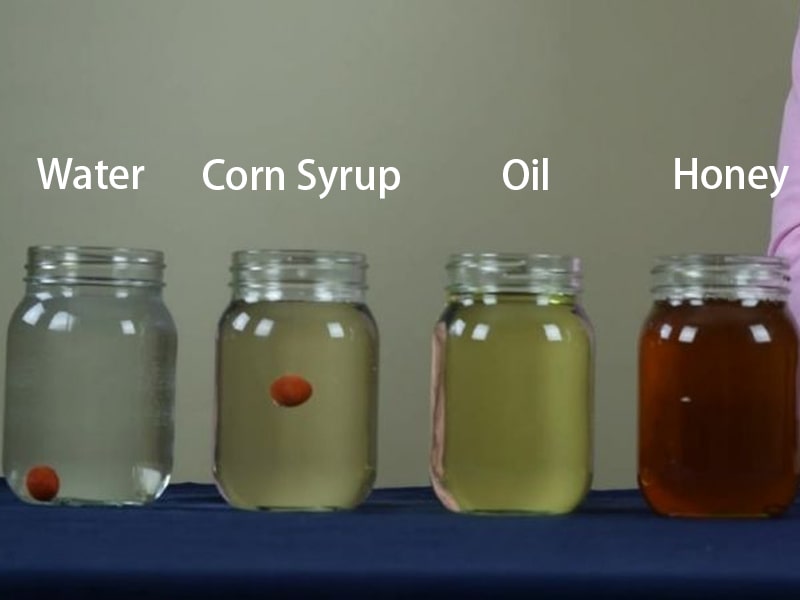

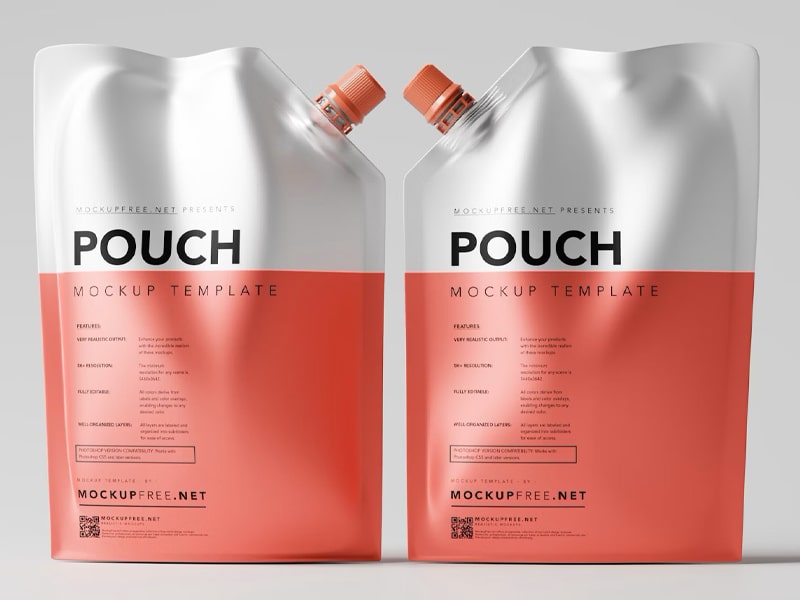

Comments